Who is Mary Magdalene really?
We know she was involved with Jesus...but how?
As his disciple?
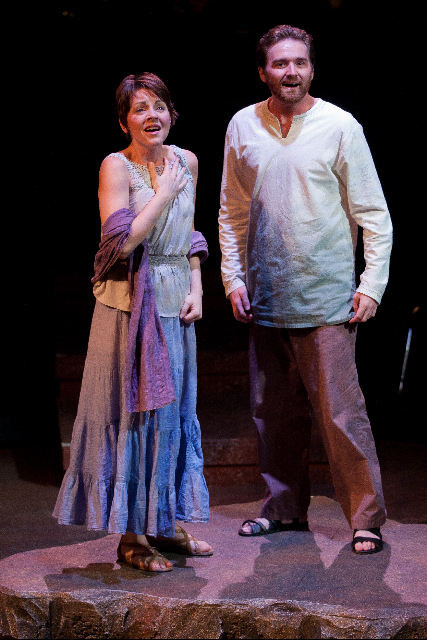
Spiritual companion?
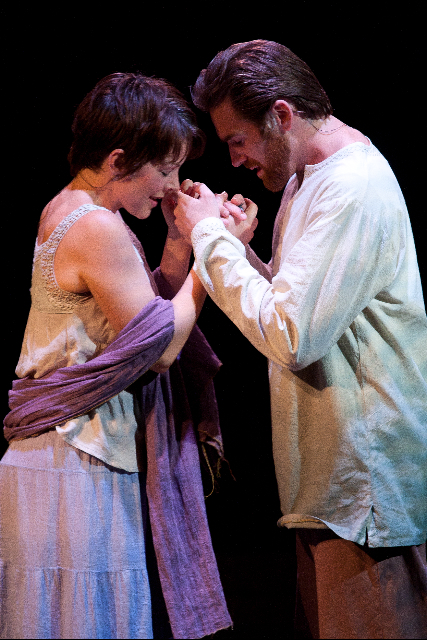
Or perhaps his wife?
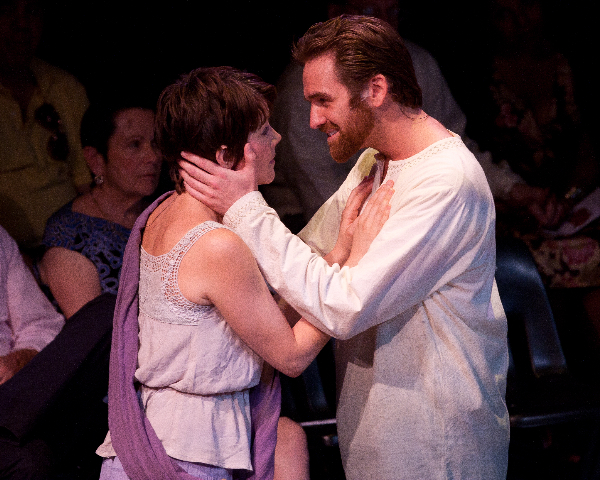
In search of an answer, we have Pope Gregory (John Antony) returning to the Church of St. Clements to denounce Mary Magdalene and the parchment she clutches in her hands, thereby emphasizing her importance for the birth of Christianity.
Only, it isn't Rome.
It is New York City and a production of The Magdalene: A Musical Play, staged in the round Off Broadway, miraculously, in the brick Theater at St. Clements!
Making creative fire out of this synchronicity, the magical full circle cast by director Richard Burk reflects the story being told: a coming back to St. Clements, Easter 591, where Magdalene is declared a prostitute identified with Mary of Bethany, named in St. John's Gospel as the sinner who anointed Jesus.
James Olm, the writer of the music as well as (with J.C. Hanley) the lyrics and book, was inspired to write a play about Magdalene in part by the writings of Margaret Starbird. It was a long haul, and his Mary seems to reflect his own questioning journey that unequivocally results in a clear identification with his subject; yet, what is admirable is the creative detachment and humor that gives it a professional polish, no doubt by the hand of award-winning creative consultant, Richard Maltby, Jr. The story backtracks from the legend of the Black Madonna whereas Magdalene leaves on a boat to France pregnant with the bloodline of Jesus, excavating the patriarchal pact that wrote her out of history and therefore denied the face of the feminine for humanity.
The musical play opens with the rousing musical number "What Did You See in Me?" a double ententdre considering Mary is joined in the song with the powerful men -- Pope Gregory and Constantine -- who could only see scarlet. That is how Mary -- as a red-haired woman draped in a red cloak -- has come down through history. The erotic image of The Last Temptation of Christ is reinforced by the Gospel of Mary, which reveals an intimacy with Jesus that made the apostles jealous.
Starbird has spent the last two decades on a personal odyssey engaging in a cross-comparative study of the relationship between Mary and Jesus. Her initial book The Woman With the Alabaster Jar inspired Dan Brown's writing of The Da Vinci Code. This pioneering right/left brain personal journey combines scholarship with intuition/synchronicities for an authentic Hero's Journey for our time. A deep intuitive understanding of Mary and Jesus as engaging in the Myth of Eternal Return for the Age of Pisces explains why Mary's role as sacred marriage (hieros gamos) partner was to powerful a connection to Song of Songs) to leave out of the New Testament. Feeling her way through this then unexplored terrain accessed by the Gospel of Mary, she pieced together a new vision of the Magdalene from what was left in.
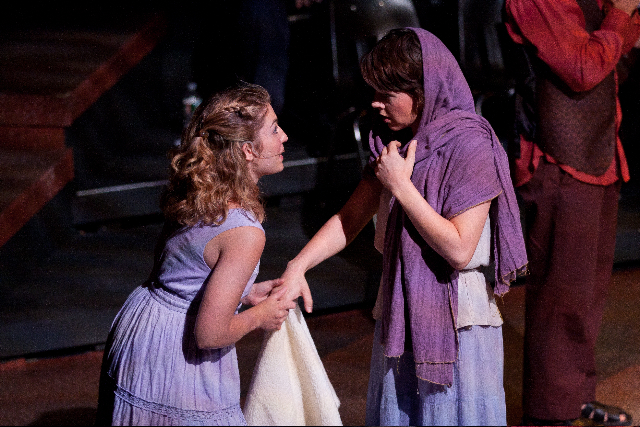
Lindsie Van Winkle as The Magdelene and Faith Engen as Little Girl who doubles as the sacrificial lamb signaling the end of the Age of Aries
The deed present, however ironically, in the gospels through a condemned act -- Mary of Bethany pouring Spikard over Yeshua's head -- was uncovered by Starbird as a reference to the ancient ritual of the hieros gamos. The temple priestess anointing a new Messiah in the changing of the ages,
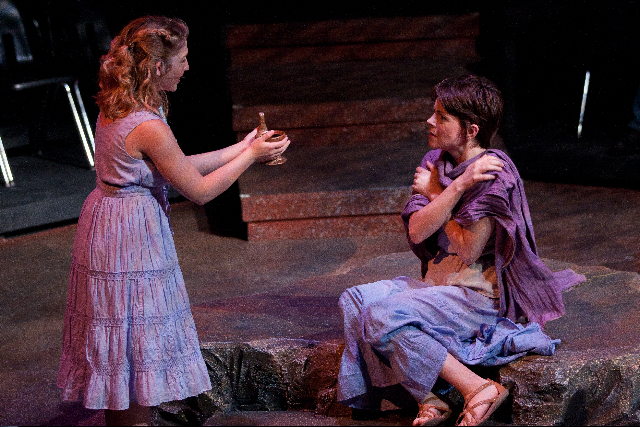
Lindsie Van Winkleas The Magdelene and Faith Engen as Little Girl who gives her the Spikard.
The Magdalene manages to poke fun where it can at the nonsense of Christian mythology (Yeshua casually proclaims he was just watching his friend's flock of sheep) which substitutes for the authenticity of ever-present origin known to Jesus. That it does so while clearing up the confusion about these splitting images of Mary in the gospels denying overall the singular role of the feminine in the early development of Christianity is no small feat.
It has Jesus naming his companion The Magdalene which means "stronghold" or "tower." The historical notes in the program state that the town of Magdala wasn't named until a hundred years after her birth. This reversal of time sequence not only points to the status a woman had in the early formation of the Christian Church, but reveals today the importance of women building the strength of The Magdalene to embody a new Aquarian Age archetype.
While this revisioning of Mary may not be radical enough for some (including myself) who would like to see her character as a magical, wise woman rather than "made" from Jesus, as in Eve being born out of Adam's rib. Yet, the character's lack of feminine center, a product of a male pen, is effectively explained in the story by the "possession of seven devils" and her desire to encounter her shadow through the dying of the white wool black, which has her expelled from her household. This Mary is highly unstable, erratically swinging between the opposites -- not unlike many erotically charged medial young women today.
And so, we have a wonderful beginning that counters the commercialism rampant in the neighborhood. The Magdalene delivers not only magic but some real adventure back into New York theater! The audience is invited to be part of the staging, which nicely reflects the reality that the collective consciousness is ready for the resurrection of Mary Magdalene, along with the face of the divine feminine in western culture.
In doing so, it applies some strong male logic to an intriguing, thoughtful and highly plausible story of Mary Magdalene's involvement with Jesus -- as erotic partner, disciple and the first to understand, from her vision in the tomb, that the love of Christ is found inside oneself. The play sheds light on the shadow she was cast into by effectively revealing the jealousy of Peter (Xander Chauncey) in her participation with the baptism and Jesus' treatment of her as equal partner. In some clever staging, it also produces the details of an obvious patriarchal pact that used her participation in the early church to condemn Jesus.
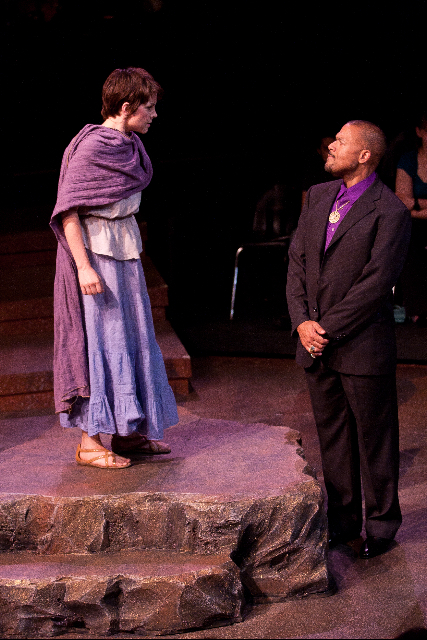
Lindsie Van Winkle as The Magdelene and Eugene Barry Hill as Pilates, brilliantly played like a TV show host
What begins with self-doubt ends in an affirming the identity of "The Magdalene" as stronghold for a (r)evolutionary form of theater that integrates sychronicities arising from the personal journey made universal in our time of paradigm leap. Rewriting history for real in St. Clements Church by inviting the audience as co-conspirators in hiding the gospel on sacred ground so it one day may be uncovered to the rejoicing of humanity.
And so it has: rewriting the patriarchal myth ruling the Age of Pisces is the best and only way to get the Myth of Eternal Return right this time, as Starbird would say, for the Age of Aquarius.
The Magdalene: A Musical Play is rousing and enjoyable musical theater as well as illuminating the dark shadows of the Christian liturgy. It may not satisfy everyone's 21st century notion of a reconfigured Mary and Jesus, but it is certainly a (r)evolutionary manner of igniting new dialogue about a post-patriarchal paradigm of equal partnership!
"The Magdalene: A Musical Play" is at the Theater at St. Clements, 423 West 46th Street in New York City.
All photos by Peter Zielenski, courtesy of Emerald Green Productions and Angelo Fraboni Productions
